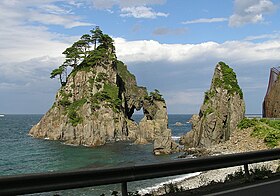Here are some trivia stuff and fun "easter eggs" found in Amachan. Some of these are just my observations. Others are from ja.wiki and those spotted by Japanese viewers and fans of Amachan. Enjoy~!
The title, "Amachan". According to danburi, the title is from the title character's name (Amano), along with her profession as Ama and it also means naïve. It is also used for a newcomer or ones with little experience.
There can only be one. 1,953 girls auditioned for the title role. The final candidates were Nounen Rena and Mine Azusa.
(info: ja.wiki)

Filming locations. The fictional rural city of North Sanriku or Kita Sanriku is primarily based on Kuji City, Iwate Prefecture, where outdoor scenes of the Hometown Arc are also filmed. The setting of Sode ga Hama (or Sodegahama) is based on Kosode village, known for its Kosode Coast, and the home of the Northernmost Ama Divers. The railway is the Sanriku Railway located at the Kuji Station. Kuji has also been "one of Japan's biggest producers of amber, dating back to almost a hundred million years ago."
(info/pic: ja.wiki, kuji amber)
( Read more... )
The title, "Amachan". According to danburi, the title is from the title character's name (Amano), along with her profession as Ama and it also means naïve. It is also used for a newcomer or ones with little experience.
There can only be one. 1,953 girls auditioned for the title role. The final candidates were Nounen Rena and Mine Azusa.
(info: ja.wiki)

Filming locations. The fictional rural city of North Sanriku or Kita Sanriku is primarily based on Kuji City, Iwate Prefecture, where outdoor scenes of the Hometown Arc are also filmed. The setting of Sode ga Hama (or Sodegahama) is based on Kosode village, known for its Kosode Coast, and the home of the Northernmost Ama Divers. The railway is the Sanriku Railway located at the Kuji Station. Kuji has also been "one of Japan's biggest producers of amber, dating back to almost a hundred million years ago."
(info/pic: ja.wiki, kuji amber)
( Read more... )
